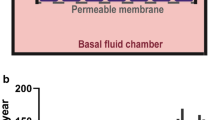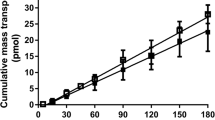Abstract
Purpose. To increase the capacity of in vitro absorption assessment and to decrease the amount of substance needed to perform early mechanistic investigations.
Methods. A liquid handling system, combined with a shaker and heating plates, was used to automate the Caco-2 cell based in vitro absorption assessment assay. In order to decrease the amount of substance needed for early mechanistic studies, a method for culturing Caco-2 cells on the lower side of polycarbonate membranes was also developed.
Results. Similar results were obtained with the automated assay as compared to manually performed assays. Data presented suggest that active transport and efflux were decreased in cells cultured on the lower side of the membranes as compared to ordinary seeded cells.
Conclusions. Implementation of a liquid handling system for in vitro absorption assessment as reported here decrease the manual workload and increases the capacity of this in vitro assay substantially. Caco-2 cells cultured on the lower side of polycarbonate membranes, as described in this article, can not be used for analysis of transport mechanisms.
Similar content being viewed by others
REFERENCES
C.-P. Lee, R. L. A. de Vrueh, and P. L. Smith. Selection of development candidates based on in vitro permeability measurements. Adv. Drug. Deliv. Rev. 23:47-62 (1997).
B. H. Stewart, O. H. Chan, N. Jezyk, and D. Fleisher. Discrimination between drug candidates using models for evaluation of intestinal absorption. Adv. Drug. Deliv. Rev. 23:27-45 (1997).
S. Yee. In vitro permeability across Caco-2 cells (colonic) can predict in vivo (small intestinal) absorption in man — Fact or myth. Pharm. Res. 14:763-766 (1997).
P. Artursson, K. Palm, and K. Luthman. Caco-2 monolayers in experimental and theoretical predictions of drug transport. Adv. Drug. Deliv. Rev. 22:67-84 (1996).
P. Artursson, J. Karlsson, G. Ocklind, and N. Schipper. Studying transport processes in absorptive epithelia, In A.J. Shaw (ed.), Epithelial Cell Culture. A Practical Approach., IRL Press, 1996, pp. 111-133.
N. G. M. Schipper, K. M. Vårum, and P. Artursson. Chitosans as absorption enhancers for poorly absorbable drugs. 1: Influence of molecular weight and degree of acetylation on drug transport across human intestinal epithelial (Caco-2) cells. Pharm. Res. 13:1686-1692 (1996).
Author information
Authors and Affiliations
Rights and permissions
About this article
Cite this article
Garberg, P., Eriksson, P., Schipper, N. et al. Automated Absorption Assessment Using Caco-2 Cells Cultured on Both Sides of Polycarbonate Membranes. Pharm Res 16, 441–445 (1999). https://doi.org/10.1023/A:1018838121975
Issue Date:
DOI: https://doi.org/10.1023/A:1018838121975




